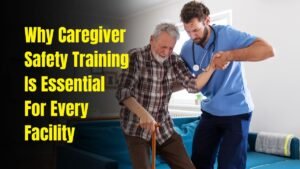Modern healthcare is more dynamic than ever before. Medical breakthroughs, emerging diseases, technological innovations, and workforce shortages are transforming how care is delivered.
To meet these challenges, healthcare systems need care teams that can quickly adapt, learn, and respond to change.
This adaptability doesn’t come from clinical skill alone—it comes from cross-disciplinary training. By bringing together nurses, physicians, therapists, social workers, and other professionals to learn collaboratively, healthcare organizations can build adaptive care teams that operate seamlessly even in unpredictable situations.
This article explores how cross-disciplinary training creates more adaptive care teams, why it works, the measurable benefits it brings, and how institutions can integrate it effectively into their workforce strategies.
What Is Cross-Disciplinary Training?
Cross-disciplinary training refers to a structured learning approach where professionals from different fields train together, share knowledge, and develop overlapping skills. It’s not just about learning side by side—it’s about integrating expertise across disciplines to improve collaboration and outcomes.
For instance:
- A nurse learns aspects of social work to better address patient needs beyond medical care.
- A physician gains insight into physiotherapy techniques to support post-surgical recovery.
- Pharmacists collaborate with nutritionists to optimize medication and dietary plans.
This interconnected training builds shared understanding, allowing teams to anticipate one another’s needs and respond collectively during high-pressure moments.
Defining Adaptive Care Teams
An adaptive care team can be described as a flexible and resilient group that adjusts quickly to evolving clinical demands, patient conditions, or environmental challenges. These teams display:
- Shared goals and mental models
- Open communication and trust
- Role flexibility
- Rapid problem-solving capabilities
- Continuous learning and reflection
In essence, adaptive care teams don’t just react—they proactively evolve to maintain high standards of care, no matter the situation.
Why Cross-Disciplinary Training Matters in Healthcare
Healthcare systems are facing unprecedented challenges—aging populations, chronic diseases, and limited resources.
Traditional siloed training often limits professionals to their roles, making coordination difficult. Cross-disciplinary training bridges that gap by developing shared competencies and mutual respect among care professionals.
Key Benefits Include:
- Improved communication across roles and departments.
- Reduced medical errors through shared situational awareness.
- Faster decision-making during emergencies.
- Higher staff morale and lower burnout rates.
- Better patient outcomes and satisfaction.
When professionals understand each other’s expertise and limitations, they can coordinate effectively—resulting in a safer, more efficient healthcare system.
How Cross-Disciplinary Training Enhances Team Adaptability
Let’s explore the core mechanisms that make cross-disciplinary training so effective in creating adaptive care teams.
1. Builds Shared Mental Models
When doctors, nurses, and allied health professionals learn together, they develop a shared understanding of care processes, terminology, and priorities. This alignment eliminates confusion during patient handovers and ensures that everyone works toward the same goal.
For example, in emergency or surgical teams, shared mental models help anticipate next steps, reduce duplication, and maintain a steady workflow even under pressure.
2. Promotes Role Flexibility
Cross-training helps professionals acquire a basic understanding of others’ responsibilities. While each member maintains core expertise, knowing how others work fosters empathy and agility.
In times of staff shortages or crises, team members can temporarily support complementary tasks within their scope, ensuring continuity of care.
3. Strengthens Communication and Trust
Hierarchies often hinder open dialogue in healthcare teams. Cross-disciplinary sessions create a safe environment for all participants to share insights, ask questions, and collaborate without fear of judgment.
This process enhances psychological safety—a crucial factor in adaptability. When everyone feels heard, the team functions as a single, coordinated unit.
4. Encourages Innovation and Problem-Solving
When people from different disciplines brainstorm together, they bring diverse perspectives to the table. This cognitive diversity sparks innovation and creative problem-solving, allowing teams to find new solutions to old problems.
Adaptive teams thrive in uncertainty because they view challenges as opportunities to experiment and learn collectively.
5. Improves Resilience During Crises
Cross-disciplinary teams are better equipped to handle disruptions such as pandemics, patient surges, or staffing shortages. By leveraging shared skills and flexible workflows, they maintain efficiency under stress—minimizing errors and preventing burnout.
Real-World Impact and Measurable Benefits
Organizations that adopt cross-disciplinary training report tangible improvements across key metrics such as patient safety, staff retention, and operational efficiency.
Below is a table summarizing some of the measurable outcomes linked to cross-disciplinary learning initiatives:
| Outcome Area | Before Training | After Cross-Disciplinary Training | Impact Summary |
|---|---|---|---|
| Medical Error Rates | Higher incidence due to miscommunication | Reduced by up to 25% in team-based environments | Improved coordination and shared understanding |
| Patient Satisfaction Scores | Average 70-75% | Increased to 85-90% | Patients report smoother care transitions |
| Staff Turnover | High due to stress and isolation | Reduced by 20-30% | Enhanced teamwork and morale |
| Decision-Making Speed | Fragmented communication delays | Response time improved by 40% | Streamlined interprofessional dialogue |
| Innovation Implementation | Slower adoption of new protocols | Faster adoption rates | Teams learn and adapt quickly to change |
These outcomes demonstrate that cross-disciplinary education doesn’t just enhance individual competence—it transforms collective performance.
Essential Components of Successful Cross-Disciplinary Training
To truly build adaptive teams, training programs must be systematic, inclusive, and continuous. Below are the key components that make cross-disciplinary initiatives successful.
1. Clear Goals and Governance
Programs should have defined objectives—whether improving communication, reducing errors, or enhancing flexibility. Leadership buy-in is critical to provide funding, time, and recognition for participants.
2. Integrated Learning Curriculum
Avoid separating disciplines during sessions. Instead, design shared modules that require collaboration:
- Case studies addressing multi-faceted patient needs
- Joint simulations of real-life emergencies
- Interdisciplinary rounds and debriefs
This integration ensures participants develop shared cognitive and emotional frameworks.
3. Role Clarity and Negotiation
At the beginning of training, each professional’s role should be clearly defined—but flexibility should be encouraged. Teams should map overlapping responsibilities and identify areas where knowledge-sharing is most beneficial.
4. Simulation-Based Learning
Simulation training is one of the most effective tools for building adaptability. High-fidelity simulations recreate emergency situations that demand quick, coordinated responses.
These experiences help participants:
- Recognize team strengths and weaknesses
- Practice communication under pressure
- Reflect and improve performance collectively
5. Continuous Feedback and Reflection
After each training session, teams should engage in structured reflection, where members discuss what went well and what can be improved. Reflection turns experience into knowledge and reinforces a growth mindset—a key element of adaptive capacity.
6. Institutional Support
Cross-disciplinary learning must be supported institutionally through:
- Protected training time
- Recognition programs for participants
- Career advancement incentives
- Dedicated facilitators to guide sessions
When supported at the organizational level, such programs become sustainable and self-improving over time.
Challenges and How to Overcome Them
| Challenge | Impact | Solution |
|---|---|---|
| Professional Silos | Limits collaboration | Use shared training spaces and interprofessional mentors |
| Hierarchy in Teams | Discourages participation | Create equal-opportunity discussions and rotate leadership roles |
| Scheduling Conflicts | Reduces participation | Offer flexible or hybrid learning models |
| Resource Constraints | Slows program rollout | Start with pilot sessions and scale gradually |
| Resistance to Change | Limits engagement | Demonstrate quick wins and success stories |
Overcoming these barriers requires strategic planning and ongoing communication. Encouraging early adopters and showcasing positive results helps build momentum for system-wide participation.
The Role of Leadership in Cross-Disciplinary Training
Leadership plays a pivotal role in cultivating an environment where team adaptability thrives. Effective leaders:
- Model interprofessional collaboration themselves
- Support training initiatives with funding and recognition
- Encourage open communication and trust
- Measure team performance and celebrate achievements
By embedding cross-disciplinary principles into organizational culture, leaders ensure adaptability becomes a habit, not a reaction.
Steps to Launch a Cross-Disciplinary Training Program
Step 1: Assess Needs
Identify gaps in teamwork, communication, and flexibility within your organization.
Step 2: Engage Stakeholders
Involve representatives from all relevant disciplines early in the planning process.
Step 3: Design the Program
Include simulations, shared case studies, and reflective learning exercises.
Step 4: Pilot and Evaluate
Start small, collect feedback, and refine the curriculum based on outcomes.
Step 5: Scale and Sustain
Expand successful modules across departments and integrate training into ongoing professional development.
Key Performance Indicators (KPIs) to Track
| Indicator | Measurement | Expected Trend |
|---|---|---|
| Communication efficiency | Surveys, response time metrics | Improvement by 30–40% |
| Patient safety events | Hospital incident reports | Reduction by 15–25% |
| Staff satisfaction | Annual staff survey | Increase by 20% |
| Training participation rate | HR tracking | Increase year-over-year |
| Implementation speed for innovations | Policy rollout timelines | Reduced lag time by half |
Regular evaluation ensures continuous improvement and demonstrates the tangible return on investment in team adaptability.
Why Adaptive Teams Are the Future of Healthcare
The healthcare industry is shifting toward integrated, value-based care. Success in this model depends heavily on collaboration across disciplines. Adaptive care teams trained through cross-disciplinary approaches will:
- Deliver coordinated, patient-centered care
- Minimize waste through efficient workflows
- Quickly integrate new technologies like AI and telehealth
- Sustain emotional resilience during crises
In short, adaptability is not optional—it’s essential for the future of healthcare.
Cross-disciplinary training is transforming healthcare by breaking silos and building bridges. It creates teams that can think together, act together, and grow together—the very essence of adaptability.
Through shared learning, communication, and flexibility, healthcare professionals become part of a dynamic ecosystem capable of delivering safer, faster, and more compassionate care. As healthcare challenges evolve, adaptive teams powered by cross-disciplinary training will stand at the forefront of innovation and excellence.
FAQs
How often should cross-disciplinary training be conducted?
Ideally, training should occur regularly, with quarterly workshops and annual simulations. Continuous learning ensures that teams retain adaptability even as staff change or new technologies emerge.
Can small healthcare facilities implement cross-disciplinary training?
Absolutely. Even small clinics can organize joint workshops and online sessions. The key is to create opportunities for collaboration and shared problem-solving, regardless of facility size.
Does cross-disciplinary training reduce burnout?
Yes. Studies have shown that when professionals understand each other’s roles and feel supported by a cohesive team, stress levels drop, and job satisfaction rises significantly.




